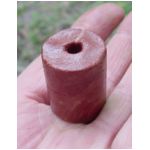
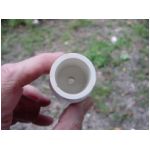
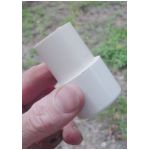
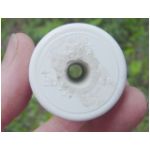
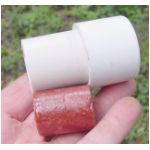
The question: "How much rcandy should I use to send my 1 pound rocket to 500 feet?"
I ran a simulation with primitive software, made some assumptions, and determined that it would be 0.9 oz. In my 4x4 tests averaged this propellant averaged 1.13 N-secs per gram. That equals 32 N-secs per ounce.
So I designed a motor around this propellant weight, using a single uninhibited propellant grain in a 1-inch diameter PVC casing.
Here are the specs:
Propellant: KN/Sucrose rcandy with 0.3 percent
red iron oxide. Burn rate at 1 atmosphere is 7 seconds per inch
OD: 1.04 inch
Length: 1.33 inches
Core: 0.25 inch
Weight: 28.1g.
Casing: Schedule 40 PVC pipe, cut 2.25 inches long. Nozzle-end
is prepared by drilling a 3/4 inch hole in the middle of an end-cap, and gluing
it on.
Nozzle: 1-1/8 inch of pressed Bentonite clay, rammed dry in 4 parts
with wooden dowel and hammer.
Drilled with 1/4 inch drill bit, then reamed with scissors to make a diverging
cone.
The grain is a little long but that doesn't matter since the head
cap is the rounded type and has a little extra space in the crown.
After gluing the cap on and all the way down, the propellant grain still
rattled back and forth a bit when shaken.
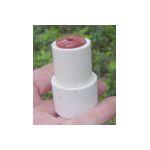
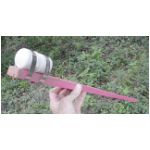
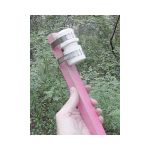
|
Motor fastened to a 45 inch stick with two band-clamps, the entire rocket weight is 482 grams. A bit over the one-pound mark, but the propellant weight is over the 0.9 oz. mark too. Ignitor is electric match with 1/4 gram of homemade black powder wrapped in masking tape. Here is another chance to make fun of my rocket lawn chair.
The funny rope hanging out of the launch tube is just a funny rope with
a brick on one end.
It serves as a plumb bob so that I can determine the launch angle with some
degree of accuracy. It is 20 degrees. 
Click here for movie of launch
(3.3 megs, 11 seconds of video)
Timings
Burn time 0.54 seconds (from audio)
Flight time: 7.8 seconds (from video)
Descent time: 4.88 seconds (from video)
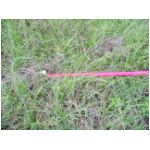

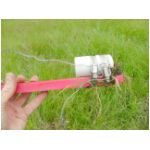
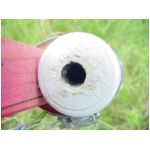

Rocket landed 115 paces from the launcher, which is about 350 feet.
Tail is pointed straight back at the launcher.
Poor thing had tangled up with the ignitor wire, which went along for the
ride.
Nozzle throat is eroded substantially, and now measures 11/32 inch.
Without any way to directly measure altitude at apogee, I made a guesstimate based upon descent time, which was 4.88 second, which would suggest an altitude of 116.7 meters = 379.3 feet. Since this does not accout for air resistance, the actual altitude was probably higher, perhaps over 400 feet, but probably not 500 feet. This difference could be accounted by the poor aerodynamics of a stick rocket, and perhaps the nozzle erosion which could reduce delivered thrust.
In any event, I am pleased that my calcs were in the ballpark, and this little PVC motor worked pretty darned well.
Please send me any comments or comments.
Jimmy Yawn
9/7/03